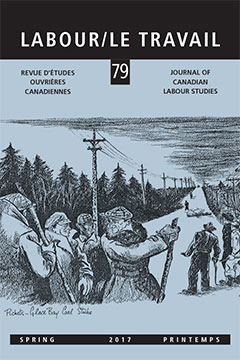From Scavengers to Sanitation Workers: Practices of Purification and the Making of Civic Employees in Toronto, 1890–1920
Published 2017-05-11
How to Cite
Abstract
In confronting the filth and decay of the early 20th century city, civic reformers often undertook ambitious programs that sought to not only eliminate the sources of disease from the urban environment but also to civilize urban dwellers, teaching them to live in pure and morally hygienic ways. Historical studies have tended to focus on the consumption side of this process, looking at how sanitary reformers and public health officials worked to establish fundamentally new understandings of household waste and its disposal, laying the foundation for the “throwaway” society of the 1950s and 1960s. However, they have tended to neglect the parallel efforts to fashion a new kind of city worker. Drawing on Toronto as a case study, this paper examines how the rise of a modern, scientifically managed waste regime in the early 20th century contributed to fundamentally new conceptions of civic employment, premised on the “purification” of the worker from the contaminating influence of neighbourhood-based patronage networks and an informal waste economy. I explore how efforts to expunge filth from urban space were paralleled by struggles to disentangle class from community-based solidarities in the labour process. Moreover, I explore how this contributed to the view that public workers somehow stood apart from the community as an anonymous and uniform service. I conclude by discussing the implications in how we think about city workers and their struggles today.
En confrontant la crasse et la décomposition de la ville du début du xxe siècle, les réformateurs civils ont souvent entrepris des programmes ambitieux visant non seulement à éliminer les sources de maladies du milieu urbain, mais aussi à civiliser les citadins, à leur apprendre à vivre de façon pure et moralement hygiénique. Les études historiques ont eu tendance à se concentrer sur le côté de la consommation de ce processus, en examinant comment les réformateurs sanitaires et les responsables de la santé publique ont travaillé à établir fondamentalement de nouvelles compréhensions des déchets ménagers et de leur élimination, établissant la fondation de la société « des jetables » des années 50 et 60. Cependant, ils ont eu tendance à négliger les efforts parallèles pour créer un nouveau type de travailleurs de la ville. En se basant sur Toronto en tant qu’étude de cas, cet article examine comment la montée d’un régime moderne et scientifique de gestion des déchets au début du 20e siècle a contribué à des conceptions fondamentalement nouvelles de l’emploi civique, fondées sur la « purification » des travailleurs de l’influence contaminatrice des réseaux de mécénat basés sur le voisinage et une économie informelle des déchets. J’examine comment les efforts visant à éliminer la saleté de l’espace urbain ont été parallèles à des luttes pour démêler les classes des solidarités basées sur les communautés dans le processus de travail. De plus, j’explore comment cela a contribué à l’idée que les travailleurs du secteur public se distinguaient en quelque sorte de la communauté en tant que service anonyme et uniforme. Je termine en discutant les implications de la façon dont nous pensons aujourd’hui des travailleurs municipaux et de leurs luttes.
